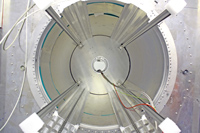 |
 |
|||||||||||||
|
|||||||||||||
|
|||||||||||||
|
After four plus one years of running time, a total budget of 21.5 million Euros, participating institutes from Helsinki to Valencia and from Novosibirsk to Glasgow and many research infrastructures successfully in place, the EU-funded infrastructure programme for ILC detector R&D EUDET comes to a close at the end of the year. Participants met for the very last EUDET meeting at DESY last week. But instead of self-congratulatory speeches and boasting summaries, most of the talks listed future plans and outlined future milestones beyond the scope of EUDET — particle physicists will be particle physicists. Many of them are already working on the next project for detector development and infrastructures, AIDA, in many ways a follow-up to EUDET.
EUDET's goal was to create so-called research infrastructures that make the lives of detector developers for the linear collider easier. Readout electronics that can be used by different detector types, mechanical structures that enable the testing of different sensor technologies, Grid-ready software for all ILC detector prototypes and a versatile beam telescope for best test beam results were on the to-do list. The conclusion from the last annual meeting last week: all tasks have been successfully completed, and all activities and tasks achieved their goals and milestones. The infrastructure is in place and is being used – not only by the participating groups, as EUDET coordinator Felix Sefkow from DESY emphasises – but by a wider community, including LHC-targeted projects. The only tasks still open are the last annual and a summarising final report to the European Commission, due early next year. All these infrastructures will continue to be used in the years to come, so EUDET is by no means over. “The EUDET community lives on in AIDA and actually gives it a nice starting point,” says former EUDET coordinator Joachim Mnich, now research director at DESY. “Both initiatives are very strong in important aspects for successful future projects: community-building and creating and exploiting synergies.” One of the less visible but very popular successes of EUDET is the "ilcinstall" package, which manages the complete download, build and install of all iLCSoft packages, which are installed on all major ILC-Grid sites. Scientists can thus use iLCSoft from anywhere in the world without having to install it. One very visible and well-travelled result is the EUDET telescope, which has served 14 user groups since May 2010 alone, has collected a total of around one billion events and over ten terabytes of data in its 84 weeks of running time. It has also travelled an amazing 8800 kilometres in its life so far — and there are more to come. Two other examples of EUDET infrastructure in place and working well are the time projection chamber TPC, which has by now collected some 22 million events in test beams, proving principles for new types of particle detectors, and written two terabytes of data to the Grid, with more pouring in as you read this because it's currently in the test beam. The second is the calorimeter, for which mechanical structures and new electronics have been built in a worldwide collaboration that, just like software developments, telescope and TPC, will continue to run and improve in the years to come. For AIDA, for example, thousands of new readout chips are available, and important tests lie ahead. So while the curtain is falling for EUDET, it is raising for AIDA, and many of the participants of last week's meeting will meet again in February at the AIDA kick-off. -- Barbara Warmbein
Read some of EUDET's milestones in ILC NewsLine
- Eudet telescope (28 June 2007, 18 October 2007, 16 July 2009, 10 June 2010) - Timepix chip and a potential readout tool for the time projection chamber (2 November 2006) - First event of the TPC prototype (11 December 2008) - TPC (19 October 2006) - The Magnet that went to space (22 November 2006, 26 July 2007) - Printed Circuit Board, for an electromagnetic calorimeter (20 May 2010) |
|||||||||||||
| © International Linear Collider |
